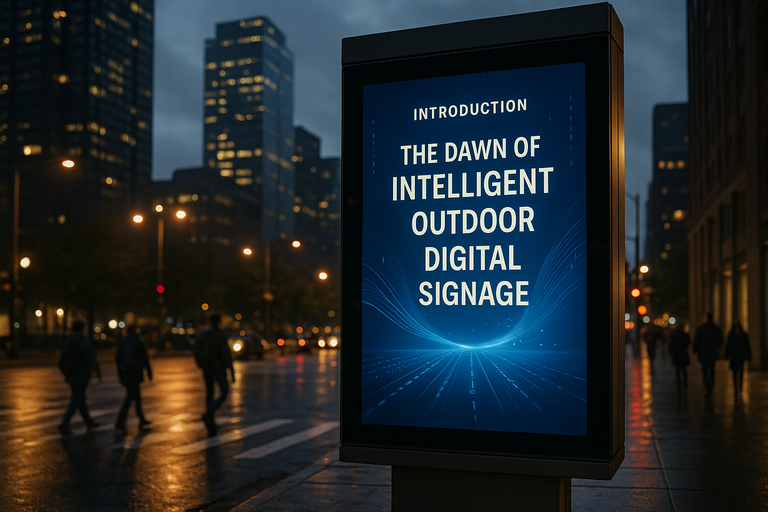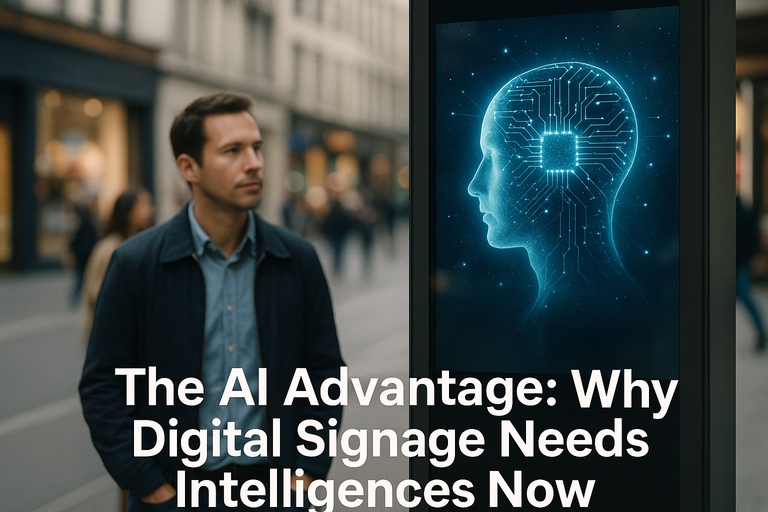AI-Powered Digital Signage: The Dawn of Intelligent Displays
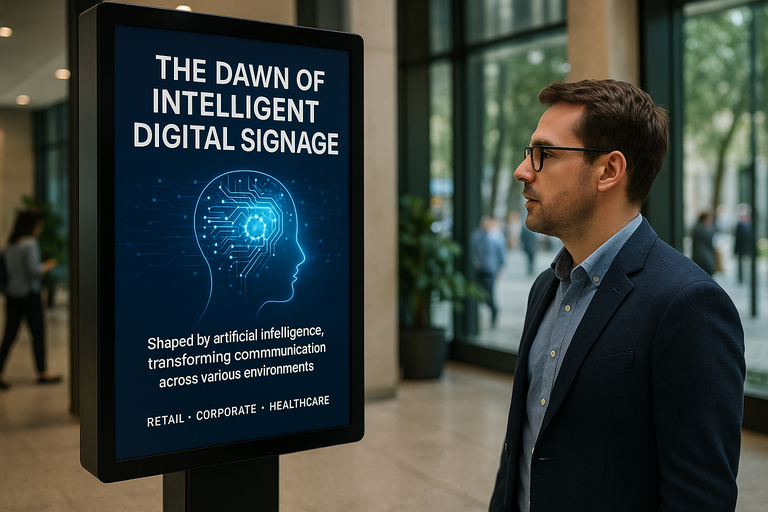
In today’s rapidly transforming digital landscape, digital signage has evolved far beyond a static noticeboard. Modern screens act as intelligent canvases—guided by AI—to deliver highly relevant messaging across retail, public spaces, corporate offices and healthcare. The convergence of AI with digital signage monitor technology is redefining how organisations communicate, promote and even care for people.
This shift is both technological and strategic: AI-driven insights, real-time responsiveness and privacy-first analytics enable personalised, adaptive communication that boosts engagement and ROI. Businesses that seize this moment unlock a new era of audience connection, operational efficiency and measurable growth.
To navigate this landscape effectively, see Navigating New Tides: How AI is Accelerating Innovation in Digital Signage for deeper implementation guidance.
AI Digital Signage Monitors: Creating Responsive Environments
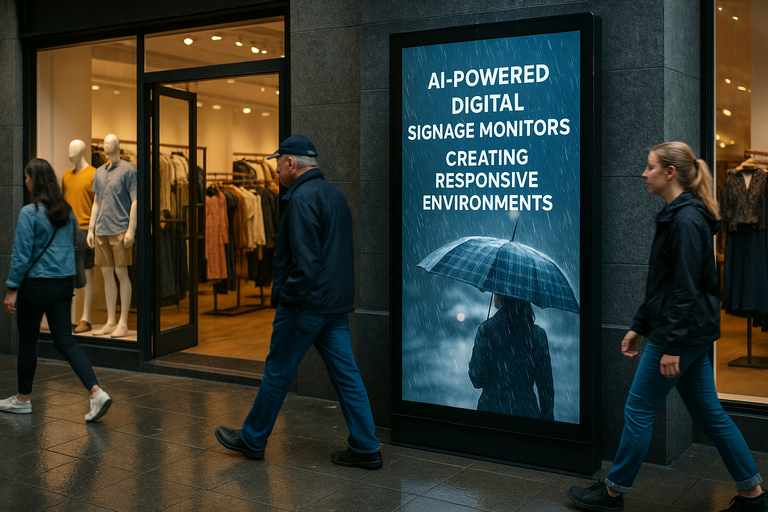
Today’s commercial displays are built for 24/7 duty cycles and high-traffic areas—the perfect foundation for AI. Integrated with computer vision and sensors, AI signage can adapt content to context in real time. For example, anonymous audience analytics (age band, attention, dwell) can optimise creative without identifying individuals, preserving compliance and trust.
Environmental data also drives relevance. A shopping-centre display can switch from “Summer Sale” creative to rainwear promos as showers start, or surface lunch offers when foot traffic peaks. Platforms like Sign Inspire provide built-in analytics for A/B tests, dwell-time tracking and auto-scheduling of top performers—so high-impact messages run during the busiest periods.
Curious about hardware differences? See Digital Signage Display vs TV: Complete Comparison Guide 2025 for durability, remote management and operational features that matter at scale.
Outdoor Digital Signage: Resilience Meets Relevance
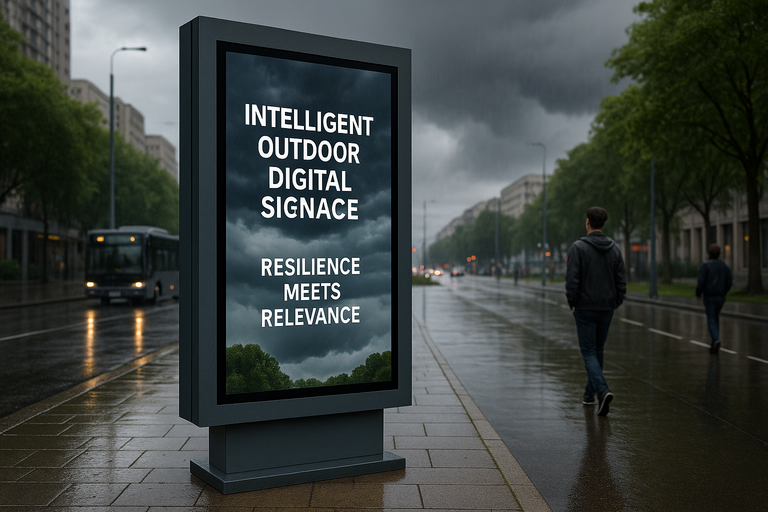
Outdoor digital signage faces sun, rain, dust and vandalism—so robust hardware is essential. Pairing that with AI elevates screens from durable billboards to dynamic communicators that read and react to their environment.
Key outdoor specs to consider:
- Brightness: ≥3,000 nits for midday sun readability
- Weather rating: IP65+ with sealed, ventilated enclosures
- Glass: Anti-glare/anti-reflective; vandal-resistant
- Thermal & power: Auto-dimming and energy optimisation
In Australian high streets and transport hubs, AI signage calibrates brightness, pivots creative to match weather and events, and pushes location-specific alerts. Networks can run regional A/B tests, monitor engagement by site and roll out instant updates from the cloud. For selection tips, see Finding the Best AI-Powered Outdoor Digital Signage Service.
Use Cases: Retail, Corporate and Healthcare Transformation

Retail: Anonymous foot-traffic insights guide creative by time of day or audience cohort; networks trigger flash sales when stock changes; social proof rotates during peak times. See In-Store Digital Display: How to Maximise Its Impact for placement tactics.
Corporate: Centralised control syncs KPIs, alerts and internal comms across sites. Wayfinding and visitor guidance reduce friction at events and campuses. Analytics in Sign Inspire help leaders identify content that drives engagement.
Healthcare: Queue updates, multilingual education and infection-control notices lower perceived wait times and reduce staff interruptions—while respecting privacy. Explore Digital Signage for Healthcare Clinics for deployment guidance.
Specs That Matter: Monitors vs TV (Quick Reference)
For commercial networks, monitors typically offer: 24/7 operation, higher brightness, remote device management, extended warranties and burn-in protection—advantages consumer TVs rarely match. See the full comparison: Digital Signage Display vs TV.
Privacy & Compliance: Responsible AI Signage
Effective AI signage is privacy-first. Follow Australia’s Australian Privacy Principles (APPs) and reference global standards (GDPR/CCPA) where relevant:
- Use anonymous analytics; avoid storing biometric identifiers
- Prefer on-device processing; minimise data retention
- Offer clear notices and opt-outs for data collection
- Audit vendors and encryption practices regularly
Measurement & ROI: From Dwell to Sales Uplift
Track dwell time, attention, content CTR, voucher redemptions and POS sales uplift. Run controlled A/B tests by daypart, creative and location. Feed outcomes back into your AI scheduler to continually improve results.
Implementation Checklist
- Hardware: Commercial monitors/LED, appropriate brightness and IP rating
- CMS: Cloud control, playback logs, user roles and approvals
- Sensors & Data: Cameras, weather, inventory, traffic, events
- Creative: Templates, dynamic fields, localisation and accessibility
- Operations: Remote updates, health monitoring, SLAs and support
Emerging Trends: Personalisation, Generative Creative and IoT
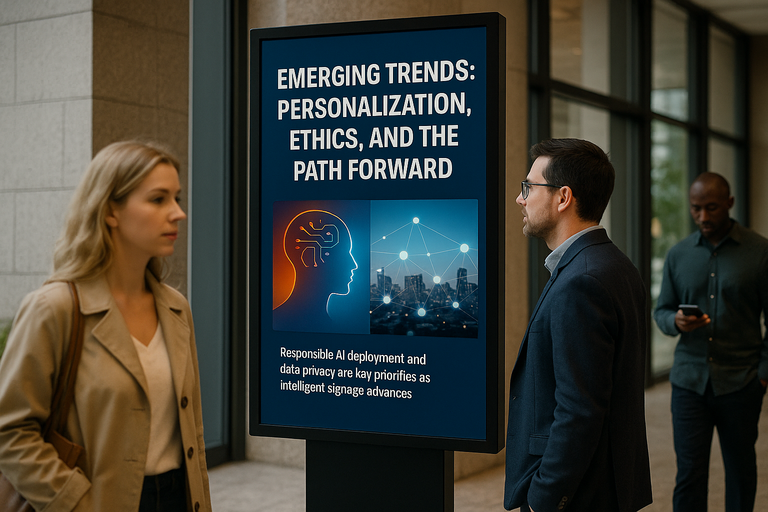
The next wave brings richer personalisation (with consent), predictive maintenance and AI-generated creative. See Elevate Your Digital Signage with AI-Driven Expanded Images. Expect deeper integrations with IoT sensors, access control and smart-city data for context-aware messaging. For forecasts, read 2025 Digital Signage Trends in Australia.
FAQs
What’s the difference between digital signage monitors and TVs?
Commercial monitors offer 24/7 operation, higher brightness, remote management and burn-in protection—ideal for business-critical networks.
How does AI personalise content without identifying people?
Anonymous signals (e.g., dwell time, estimated demographics) inform scheduling. No biometric IDs are stored; processing can be on-device.
Which outdoor specs matter most?
Aim for ≥3,000 nits, IP65+ weather protection, anti-glare glass and vandal-resistant enclosures with thermal management.
How do we prove ROI?
Measure dwell, CTR, redemptions and POS uplift; run A/B tests and compare performance by daypart, location and audience cohort.
Is AI signage compliant with Australian privacy laws?
Yes—when aligned with the APPs, using minimal data retention, clear notices and strong encryption.
Conclusion: The Future of AI-Powered Digital Signage
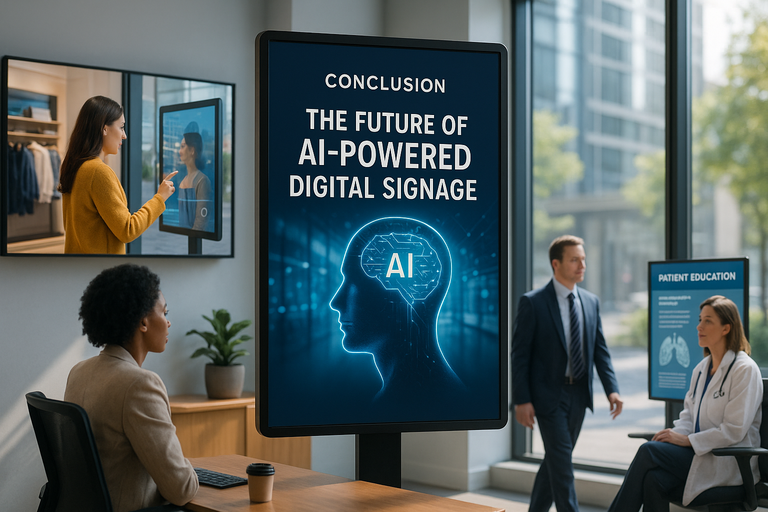
From responsive indoor monitors to weather-hardened outdoor networks, AI is transforming screens into context-aware, measurable communication assets. Early adopters gain higher engagement, efficiency and ROI—while privacy-first design maintains trust. The union of AI and digital signage is not just the future; it’s a strategic imperative for the present.

